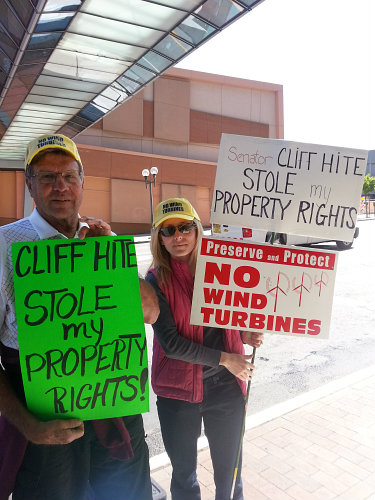American Wind Energy Assoc. hammered by protestors (Ohio)
Sep 25, 2013
Editor’s note: The following is a report on a demonstration recently held in Columbus, Ohio, against the American Wind Energy Association, which was holding a so-called Midwest Summit.


Friends,
A great day in Columbus, Ohio, with about thirty protesting citizens marching in front of the Hilton Hotel where the American Wind Energy Association was holding its Midwest Summit.
It was an IMPORTANT effort coordinated by the Interstate Concerned Citizens and Kevon Martis. We were joined by wind warriors from Indiana, Michigan and Pennsylvania! Thank you!
Woody Allen said once that “Eighty per cent of success is just showing up.” Amen. Please read the breaking coverage from the legislature’s news service. Woody was right.
Diane and Julie.
“Wind Industry, Other Groups Gear Up For Fight Over Green Energy Law” (Gongwer Report)
On the eve of a key senator’s unveiling of his plan to overhaul Ohio’s clean energy law, the wind industry warned that the proposed changes cloud a sunny forecast for renewable energy development in the state.
The American Wind Energy Association’s news conference on Tuesday kicked off what will likely be a pitched battle over Republican efforts to scale back the state’s renewable energy and energy efficiency requirements on electric utilities (SB221, 127th General Assembly).
Wind energy opponents also rallied against “industrial wind cronyism and taxpayer fleecing” in Columbus Tuesday afternoon, and the Ohio Advanced Energy Economy Institute scheduled a news conference Wednesday morning to tout a report on the benefits of the clean energy law.
Wednesday afternoon the Senate Public Utilities Committee is set to accept a substitute version of placeholder legislation (SB 58) that Chairman Sen. Bill Seitz (R-Cincinnati) introduced earlier this year.
Among other things, the substitute version would eliminate the requirement for half of the 12.5% of Ohio’s electricity supply to come from renewable energy facilities located in the state, Sen. Seitz said last month. The sponsor said a federal court ruling found in-state energy preferences elsewhere were an unconstitutional violation of the Commerce Clause. (See Gongwer Ohio Report, August 21, 2013)
Eric Thumma, director of institutional relations for Iberdrola Renewables, said the in-state renewable energy requirement was a “prime driver” for the company to construct the 304-megawatt Blue Creek Wind Farm in Van Wert and Paulding counties.
“The great thing about the Ohio requirement is you’re getting energy from Ohio, you’re getting investment in Ohio,” he said.
“The policies that the Ohio General Assembly put in place are working. We’re meeting the benchmarks,” he said, urging lawmakers not to alter the renewable energy portfolio standards (RPS).
Susan Innis, senior manager of public affairs for Vestas, said Ohio’s RPS, combined with a robust supply chain and proximity to wind farms, makes the state fertile ground for wind turbine manufacturers.
New technology that enables turbines to generate electricity with winds as slow as six miles per hour have also made wind power more viable in the state, she said.
Dayna Baird, contract lobbyist for AWEA, said changes to the RPS could jeopardize development of the seven proposed wind farm projects that have already been certified by the Ohio Power Siting Board and are ready to move forward.
Wind developers are waiting for electric utilities to issue the next request for proposals to secure a long-term contract before breaking ground on the projects, she said. “When the next RFP does come out, there’s going to be a lot of serious competition.”
Meanwhile, another group protested what it called “the lies and manipulation” of the wind industry and its legislative allies during a rally scheduled later in the day.
Kevon Martis, of Interstate Concerned Citizens, said elected officials allowed the industry to encroach on private property and endanger the wellbeing of rural residents.
“The emperor has no clothes and it is time the media and state legislatures admit it,” he said in a news release.
The wind industry is dependent on “massive public subsidy at both the federal and local level as well as on unconstitutional state mandates,” the group said, and warned that other countries are working to undo policies that encourage wind development.
“The U.S. and Ohio should learn from the failures abroad, and stop wasting taxpayer dollars on an endeavor destined to raise electricity rates, make the U.S. a less attractive place to manufacture and ultimately costing jobs,” Interstate Concerned Citizens said.
In other developments, the Ohio Advanced Energy Economy Institute said it would unveil an Ohio State University study that shows Ohioans will pay $3.65 billion more on their electricity bills over the next 12 years if Sen. Seitz’s proposal is enacted.
Ohioans saved 1.4% on their electricity bills since energy efficiency and renewable energy standards were enacted in 2008, according to the study. The law also stimulated investment in the energy sector that expanded gross domestic product by $160 million in 2012, and created more than 3,200 Ohio jobs in the period from 2008 to 2012.
Sen. Seitz has said his bill would also make it easier for electric utilities to comply with the state’s energy efficiency standards and limit the amount they could spend on the mandate.

Comment by Robert W. Rand, INCE on 09/25/2013 at 1:24 pm
It appears that among the benchmarks achieved by Iberdrola, the Blue Creek Wind facility has generated widespread noise complaints [1]. Members of at least 14 families have complained … that “the noise from the wind turbines is loud, annoying, and disturbing. Members of two of these families have informed me that turbine noise prevents them from falling asleep or awakes them at night.”
The acoustical consultant, Mark Bastasch, P.E. of CH2M HILL, designed the facility to impact hundreds of homes with noise levels over 40 dBA [2,3,4]. Twenty-two homes were predicted to receive wind turbine noise levels 50 dBA or higher; another 225 homes with noise levels 47-49 dBA; another 230 homes with noise levels 44-46 dBA; another 144 homes with noise levels 41-44 dBA.
In quiet rural areas, wind turbine noise complaints surface at 32-33 dBA and rise quickly. This has been known since 2004. Wind turbine noise levels over 40 dBA are guaranteed to create widespread complaints, appeals to stop the noise and legal action. For Blue Creek Wind’s late 2009 reports, 2008 data were readily available for an early 2009 lawsuit in Mars Hill, Maine, where wind turbine noise levels over 40 dBA were found in the area where the lawsuit emerged.
These facts were ignored?
Professional acoustical consultants design power generation facilities to prevent noise complaints and be good acoustic neighbors. This is good engineering practice. INCE members and PEs are required by their professional memberships to hold paramount the safety, health and welfare (wellbeing) of the public. Not some of the public, or some of the time. All of the public, all the time.
The complaints at Blue Creek Wind suggest a different approach was taken.
It appears that either Iberdrola was misled by their acoustic consultant or Iberdrola willingly chose to create noise complaints and harm neighbors.
1. http://docs.wind-watch.org/Champaign-4-Schaffner.pdf
2. http://iberdrolarenewables.us/bluecreek/
3. http://iberdrolarenewables.us/bluecreek/docs/primary/03-Appendices/_T-Noise-Analysis-Report/Final-IBR-BlueCreek-Noise-121409-complete.pdf, Table B-1.
4. http://iberdrolarenewables.us/bluecreek/docs/final-amendment-04122011/3-Appendices/T_Noise_Analysis_Report/App_T1a_IBR_BlueCreek_Noise_03292011.pdf